Unsupervised Machine Learning, Multi-Attribute Analysis for Identifying Low Saturation Gas Reservoirs within the Deepwater Gulf of Mexico, and Offshore Australia
Abstract
:1. Introduction
2. Geologic Settings
2.1. King Kong and Lisa Anne Prospects, Offshore Gulf of Mexico
2.2. Ursa Gas Field, Offshore Gulf of Mexico
2.3. Scarborough Gas Field, Offshore Australia
3. Methodology
3.1. Available Data
3.2. Methods and Workflow
4. Results
4.1. KK/LA SOM Results
4.2. Ursa SOM Results
4.3. Scarborough SOM Results
5. Discussion
6. Conclusions
Author Contributions
Funding
Data Availability Statement
Acknowledgments
Conflicts of Interest
References
- Zhao, B.; Zhou, H.; Hilterman, F.J. Fizz and gas separation with SVM classification. In Proceedings of the SEG Annual Meeting, Houston, TX, USA, 6–11 November 2005. [Google Scholar] [CrossRef]
- Hilterman, F.J. Seismic Amplitude Interpretation; Society of Exploration Geophysicists: Houten, The Netherlands; European Association of Geoscientists and Engineers: Houten, The Netherlands, 2001. [Google Scholar] [CrossRef]
- O’Brien, J. Seismic amplitudes from low gas saturation sands. Lead. Edge 2004, 23, 1236–1243. [Google Scholar] [CrossRef]
- Ray, A.; Key, K.; Bodin, T.; Myer, D.; Constable, S. Bayesian inversion of marine CSEM data from the Scarborough gas field using a transdimensional 2-D parametrization. Geophys. J. Int. 2014, 199, 1847–1860. [Google Scholar] [CrossRef] [Green Version]
- Zhu, F. Shear-Wave Velocity Estimation Using Multiple Logs and Multicomponent Seismic AVO Interpretation: Gulf of Thailand. Ph.D. Thesis, Texas A&M University, College Station, TX, USA, 2010. [Google Scholar]
- Zhou, Z.; Hilterman, F.J. A comparison between methods that discriminate fluid content in unconsolidated sandstone reservoirs. Geophysics 2010, 75, B47–B58. [Google Scholar] [CrossRef]
- Laiw, A. Low Saturation Gas Reservoirs Discrimination—An Integrated Approach. In Proceedings of the 73rd EAGE Conference and Exhibition, Vienna, Austria, 23–27 May 2011. [Google Scholar] [CrossRef]
- Roden, R.; Smith, T.; Sacrey, D. Geologic pattern recognition from seismic attributes: Principal component analysis and self-organizing maps. Interpretation 2015, 3, SAE59–SAE83. [Google Scholar] [CrossRef]
- Roden, R.; Chen, C.W. Interpretation of DHI characteristics with machine learning. First Break 2017, 35. [Google Scholar] [CrossRef]
- Sacrey, D.; Roden, R. Solving exploration problems with machine learning. First Break 2018, 67–72. [Google Scholar] [CrossRef]
- Chopra, S.; Marfurt, K.J. Unsupervised machine learning applications for seismic facies classification. In Proceedings of the Unconventional Resources Technology Conference, Denver, CO, USA, 22–24 July 2019; pp. 3135–3142. [Google Scholar] [CrossRef]
- Roden, R.; Smith, T.A.; Santogrossi, P.; Sacrey, D.; Jones, G. Seismic interpretation below tuning with multiattribute analysis. Lead. Edge 2017, 36, 330–339. [Google Scholar] [CrossRef]
- Batzle, M. Seismic Evaluation of Hydrocarbon Saturation in Deep-Water Reservoirs; Colorado School of Mines: Golden, CO, USA, 2016. [Google Scholar] [CrossRef]
- Han, C. Understanding frequency decomposition colour blends using forward modelling—Examples from the Scarborough gas field. First Break 2018, 36, 53–60. [Google Scholar] [CrossRef]
- Driscoll, N.W.; Karner, G.D. Lower crustal extension across the Northern Carnarvon basin, Australia: Evidence for an eastward dipping detachment. J. Geophys. Res. Solid Earth 1998, 103, 4975–4991. [Google Scholar] [CrossRef]
- Foschi, M.; Cartwright, J.A. Seal failure assessment of a major gas field via integration of seal properties and leakage phenomena. AAPG Bull. 2020, 104, 1627–1648. [Google Scholar] [CrossRef]
- Glenton, P.N.; Sutton, J.T.; McPherson, J.G.; Fittall, M.E.; Moore, M.A.; Heavysege, R.G.; Box, D. Hierarchical approach to facies and property distribution in a basin-floor fan model, Scarborough Gas Field, North West Shelf, Australia. In Proceedings of the IPTC 2013: International Petroleum Technology Conference, Beijing, China, 26–28 March 2013; p. cp-350. [Google Scholar] [CrossRef]
- Brown, A.R. Interpretation of Three-Dimensional Seismic Data; Society of Exploration Geophysicists: Tulsa, OK, USA; American Association of Petroleum Geologists: Tulsa, OK, USA, 2011. [Google Scholar] [CrossRef] [Green Version]
- Castagna, J.P.; Backus, M.M. Offset-Dependent Reflectivity—Theory and Practice of AVO Analysis; Society of Exploration Geophysicists: Houston, TX, USA, 1993. [Google Scholar] [CrossRef]
- Chopra, S.; Castagna, J.P. AVO; Society of Exploration Geophysicists: Houston, TX, USA, 2014. [Google Scholar] [CrossRef]
- Khalid, P.; Ghazi, S. Discrimination of fizz water and gas reservoir by AVO analysis: A modified approach. Acta Geod. Geophys. 2013, 48, 347–361. [Google Scholar] [CrossRef]
- Wojcik, K.M.; Gonzalez, E.; Vines, R.E. Derisking low-saturation gas in Tertiary turbidite reservoirs. Interpretation 2016, 4, SN31–SN43. [Google Scholar] [CrossRef]
- Han, D.H.; Batzle, M. Fizz water and low gas-saturated reservoirs. Lead. Edge 2002, 21, 395–398. [Google Scholar] [CrossRef]
- Wu, X.; Chapman, M.; Li, X.Y.; Boston, P. Quantitative gas saturation estimation by frequency-dependent amplitude-versus-offset analysis. Geophys. Prospect. 2014, 62, 1224–1237. [Google Scholar] [CrossRef] [Green Version]
- Jolliffe, I.T. Mathematical and statistical properties of population principal components. Princ. Compon. Anal. 2002, 10–28. [Google Scholar] [CrossRef]
- Sacrey, D.; Roden, R. Understanding Attributes and Their Use in the Application of Neural Analysis–Case Histories Both Conventional and Unconventional. Search Discov. Artic. 2014, 41473. [Google Scholar]
- La Marca, K.; Bedle, H. Deepwater seismic facies and architectural element interpretation aided with unsupervised machine learning techniques: Taranaki basin, New Zealand. Mar. Pet. Geol. 2022, 136. [Google Scholar] [CrossRef]
- Kohonen, T. The self-organizing map. Proc. IEEE 1990, 78, 1464–1480. [Google Scholar] [CrossRef]
- Roden, R.; Santogrossi, P. Significant advancements in seismic reservoir characterization with machine learning. First–SPE Nor. Mag. 2017, 3, 14–19. [Google Scholar]
- Smith, T.; Treitel, S. Self-organizing artificial neural nets for automatic anomaly identification. In SEG Technical Program Expanded Abstracts; Society of Exploration Geophysicists: Houston, TX, USA, 2010; pp. 1403–1407. [Google Scholar]
- Taner, M.T.; Koehler, F.; Sheriff, R.E. Complex seismic trace analysis. Geophysics 1979, 44, 1041–1063. [Google Scholar] [CrossRef]
- Chopra, S.; Marfurt, K.J. Seismic attributes—A historical perspective. Geophysics 2015, 70, 3SO–28SO. [Google Scholar] [CrossRef]
- Taner, M.T. Seismic attributes. Can. Soc. Explor. Geophys. Rec. 2001, 26, 49–56. [Google Scholar]
- Subrahmanyam, D.; Rao, P.H. Seismic attributes—A review. In Proceedings of the 7th International Conference & Exposition on Petroleum Geophysics, Hyderabad, India, 16–19 September 2008; pp. 398–404. [Google Scholar]
- Radovich, B.J.; Oliveros, R.B. 3-D sequence interpretation of seismic instantaneous attributes from the Gorgon field. Lead. Edge 1998, 17, 1286–1293. [Google Scholar] [CrossRef]
- Hart, B. Channel detection in 3-D seismic data using sweetness. AAPG Bull. 2008, 92, 733–742. [Google Scholar] [CrossRef]
- Koson, S.; Chenrai, P.; Choowong, M. Seismic attributes and their applications in seismic geomorphology. Bull. Earth Sci. Thail. 2013, 6, 1–9. [Google Scholar]
- Avseth, P.; Flesche, H.; Van Wijngaarden, A.J. AVO classification of lithology and pore fluids constrained by rock physics depth trends. Lead. Edge 2003, 22, 1004–1011. [Google Scholar] [CrossRef]
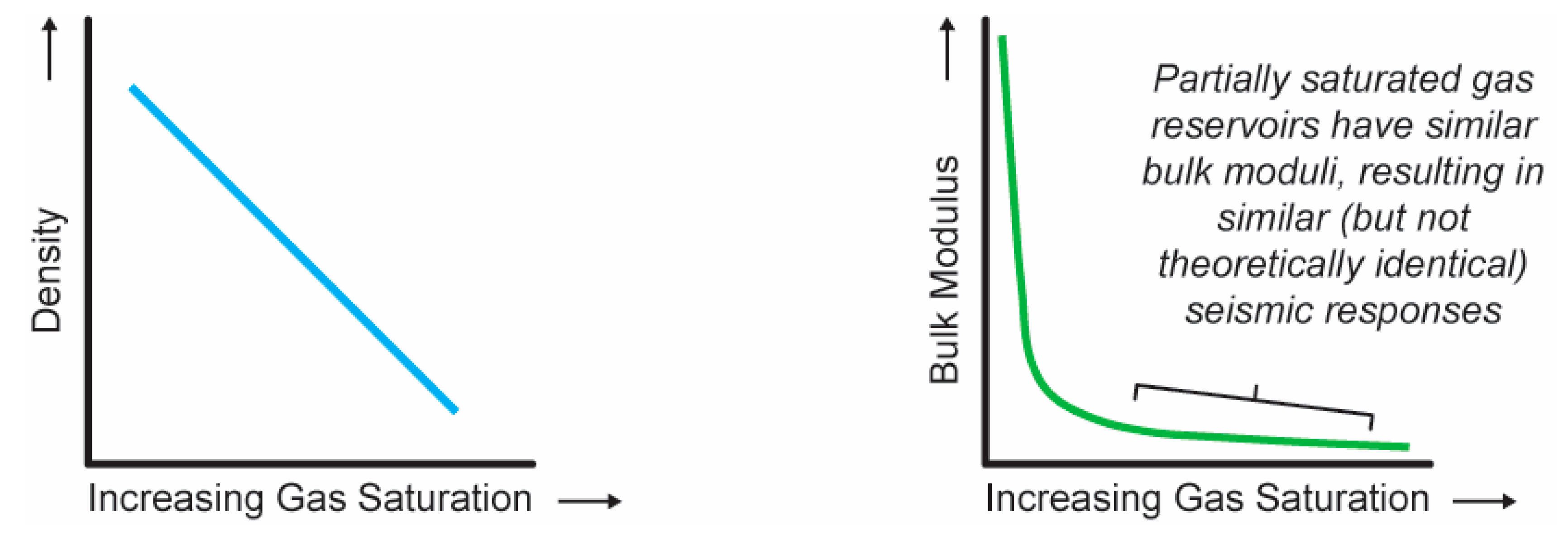
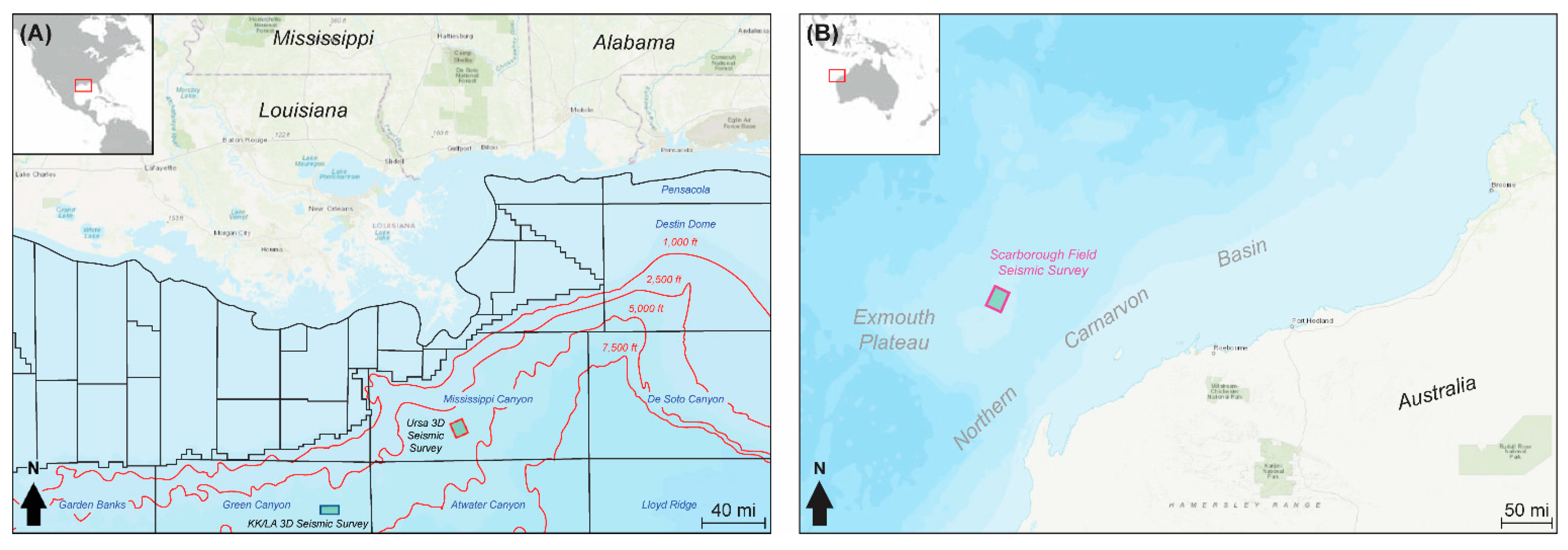


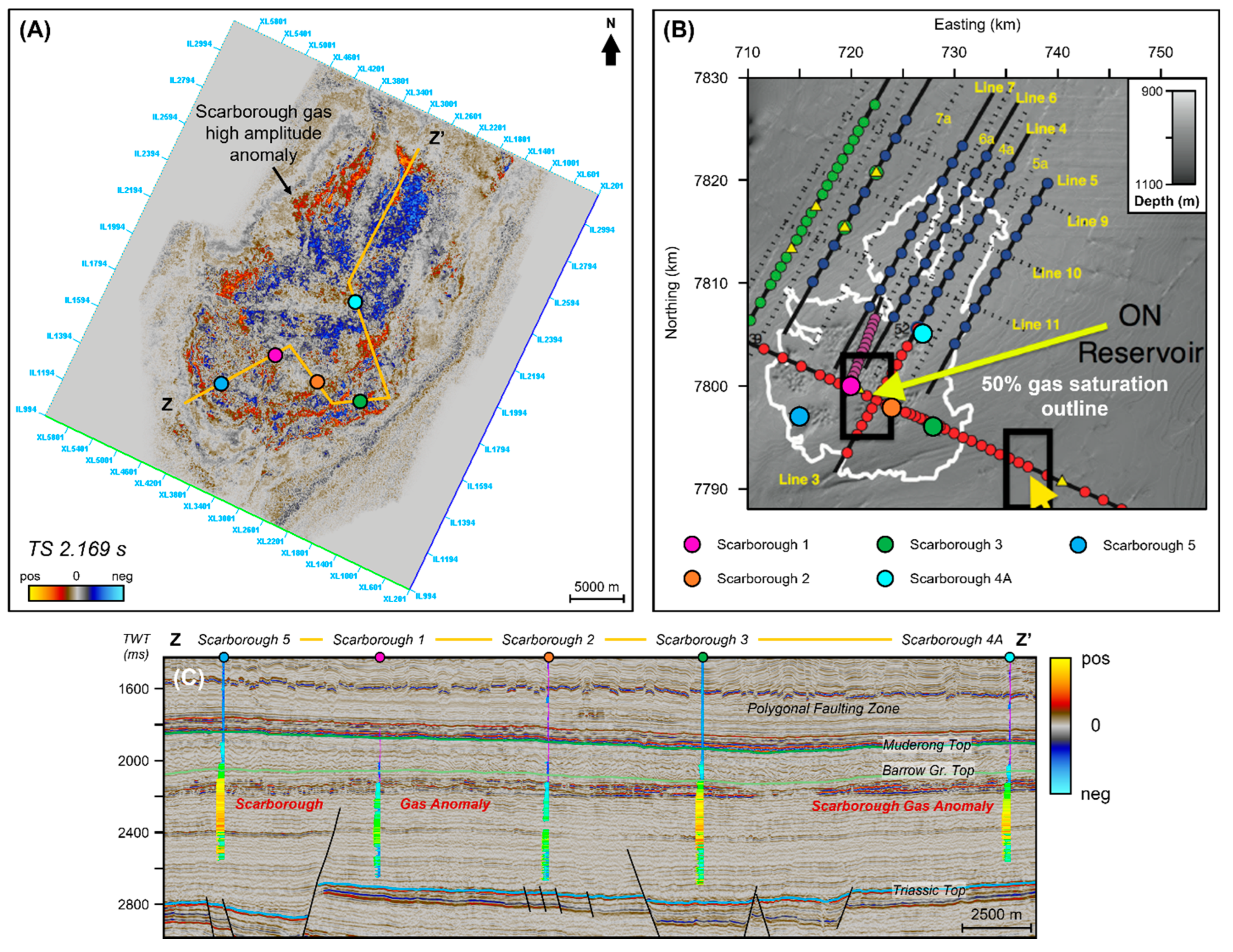
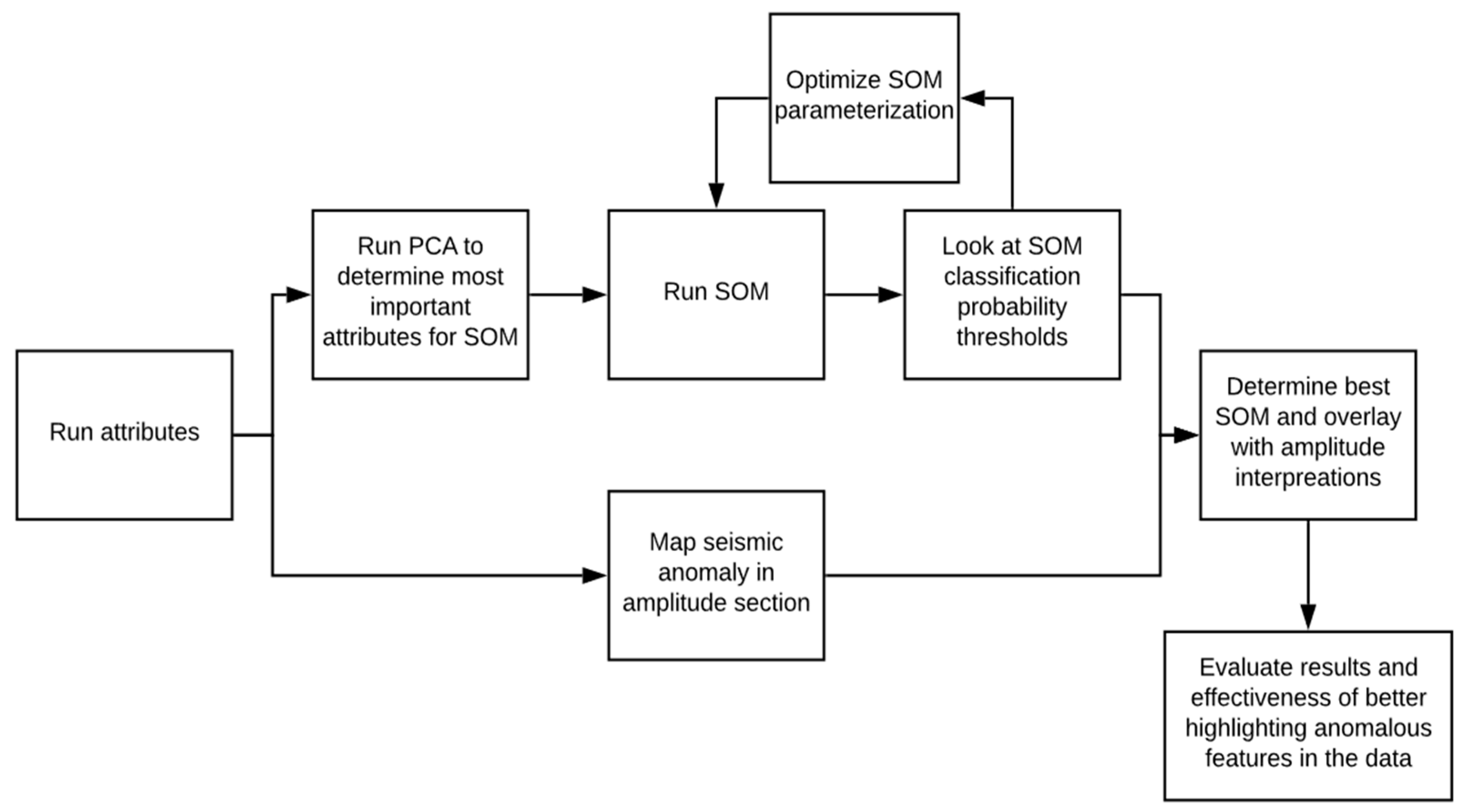

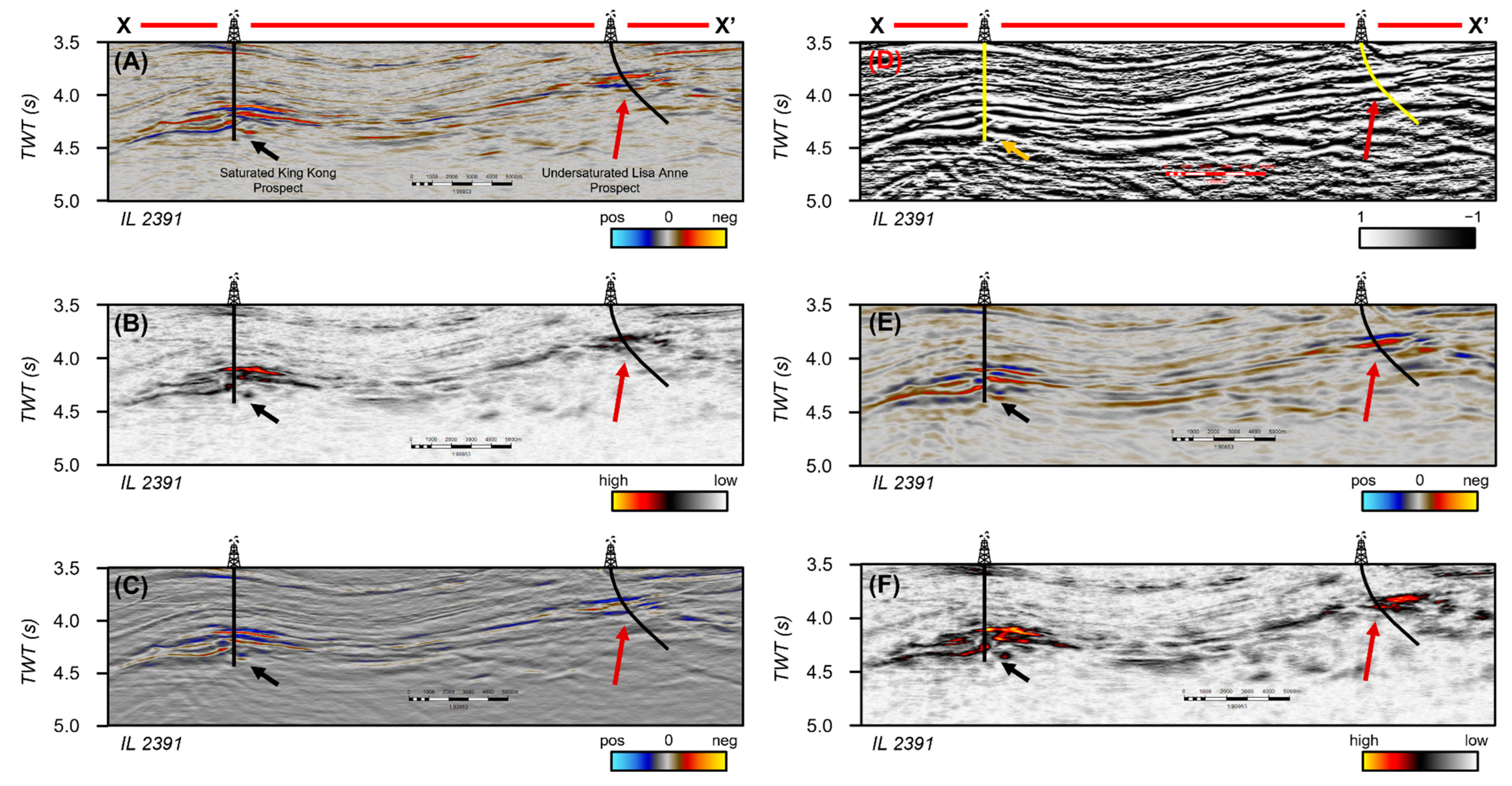
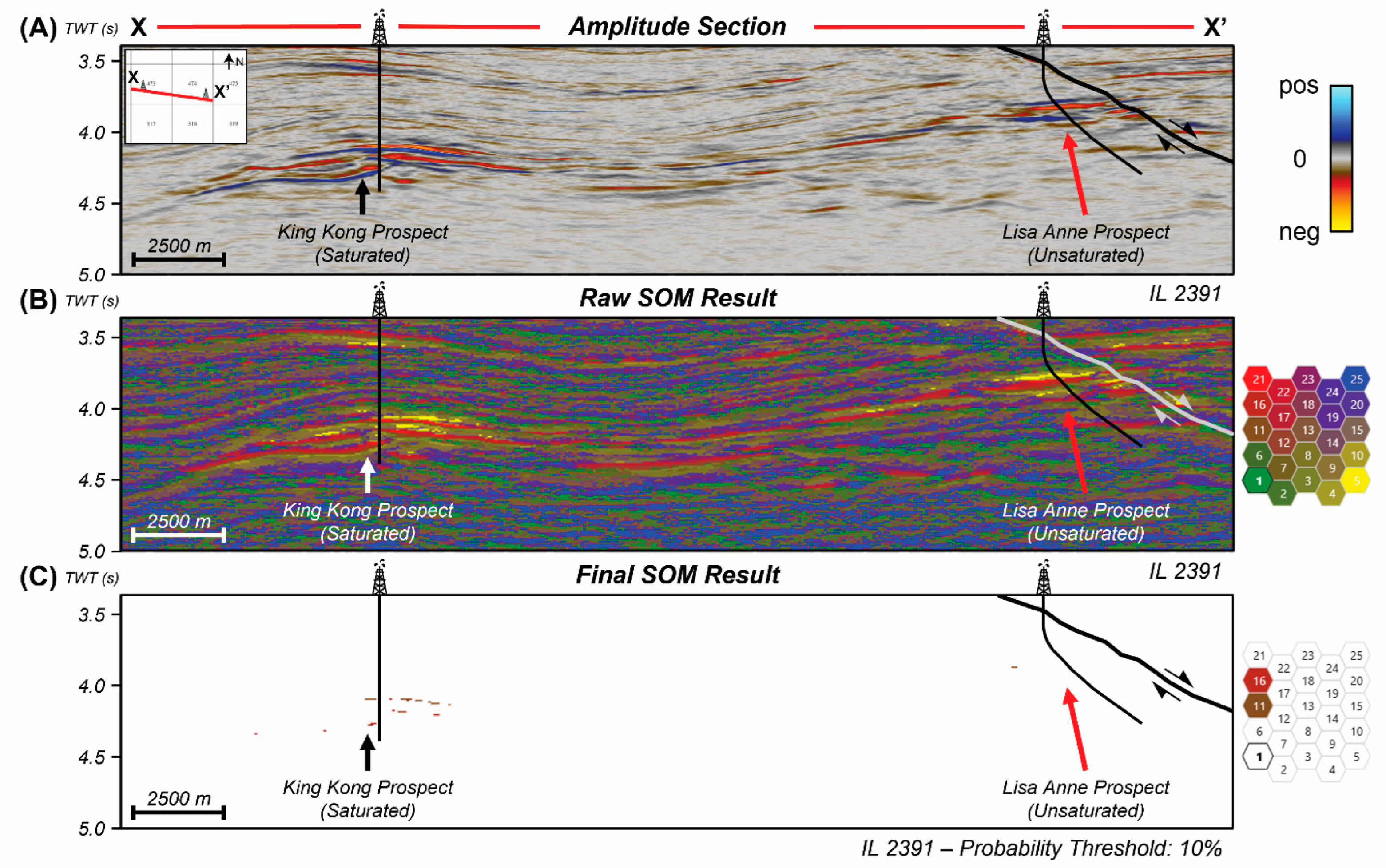
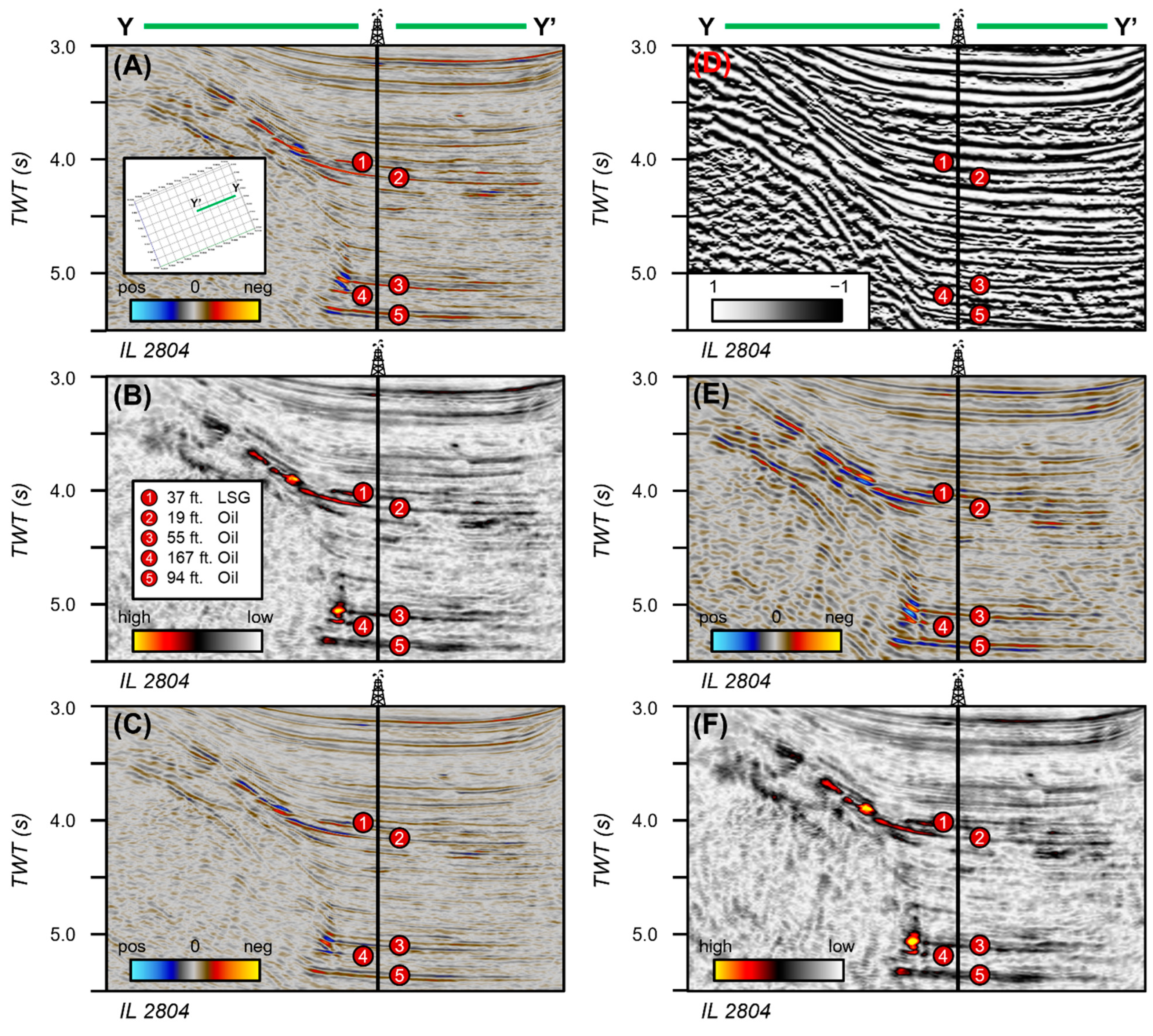
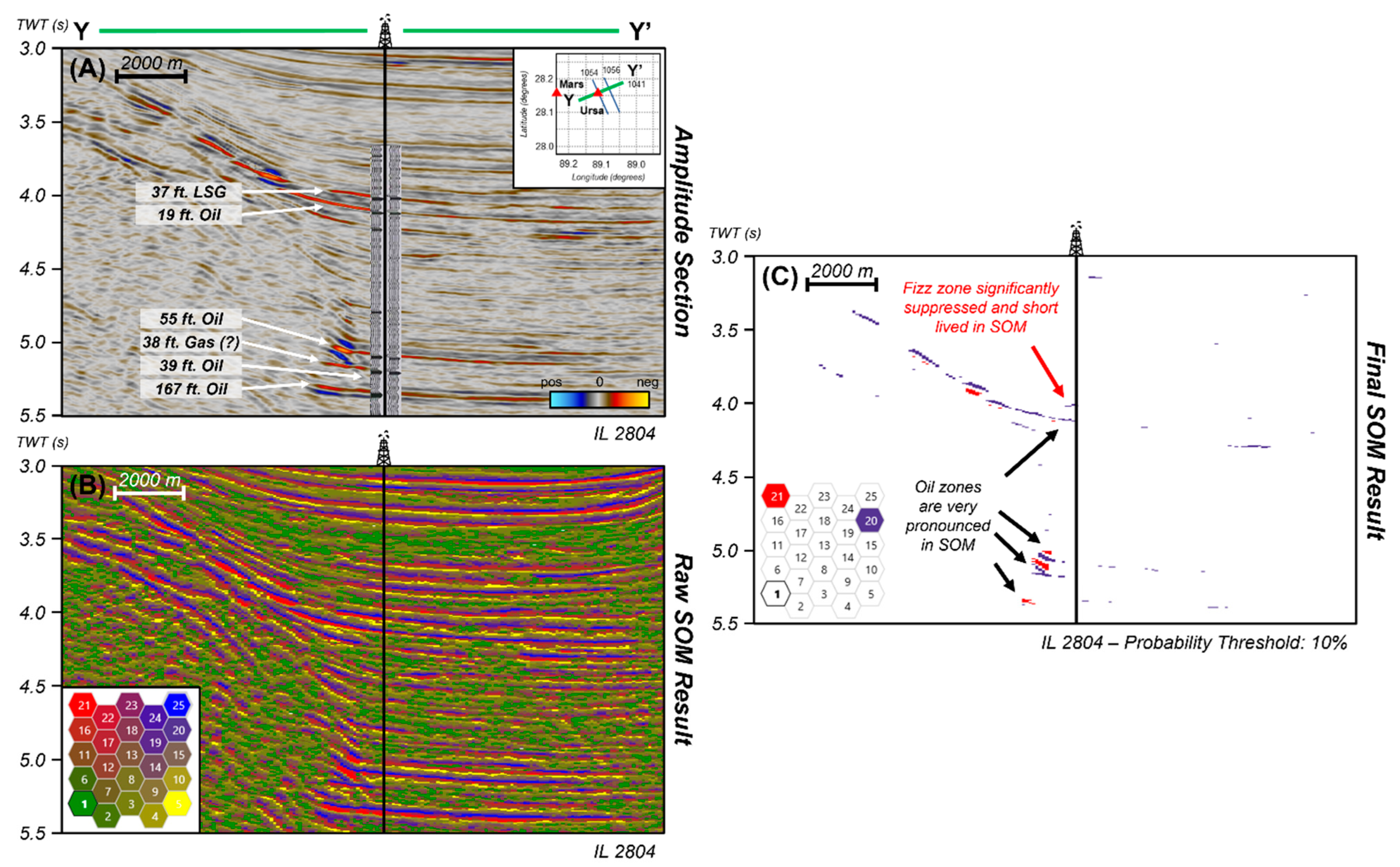
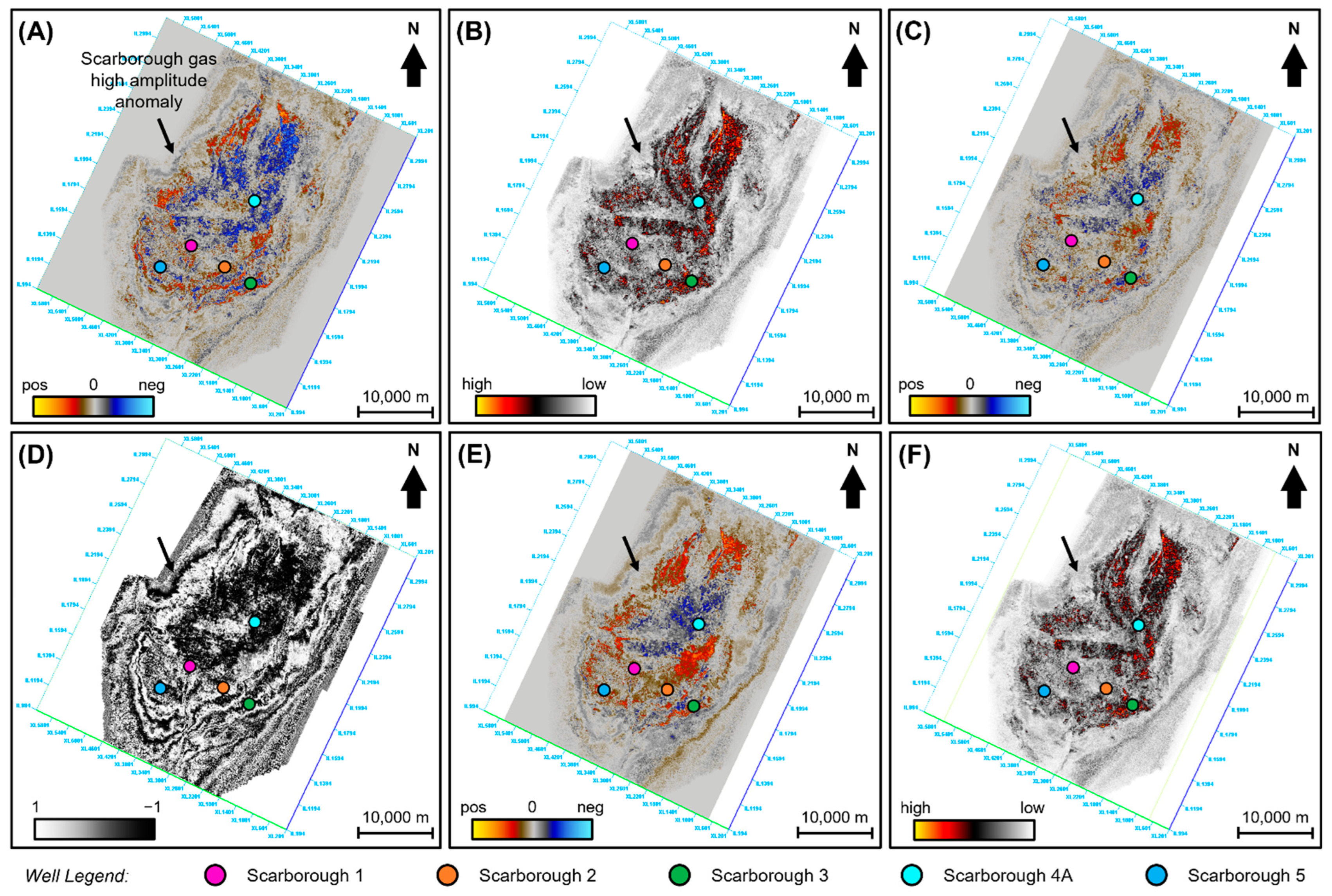
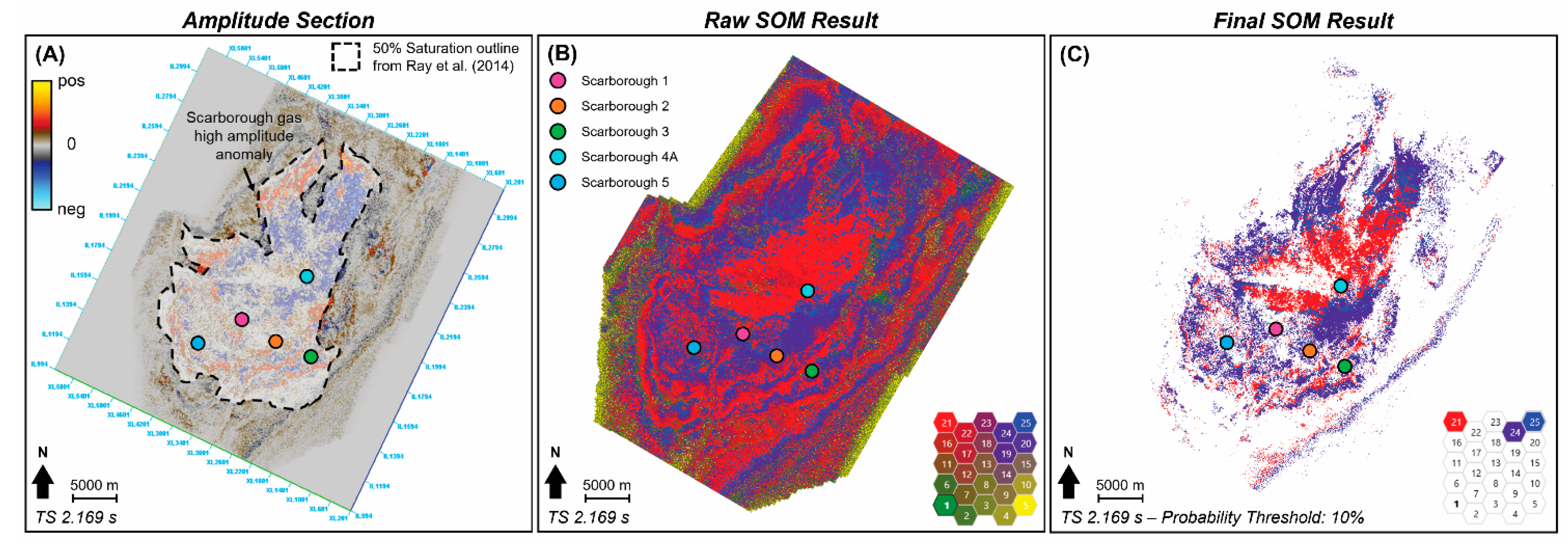
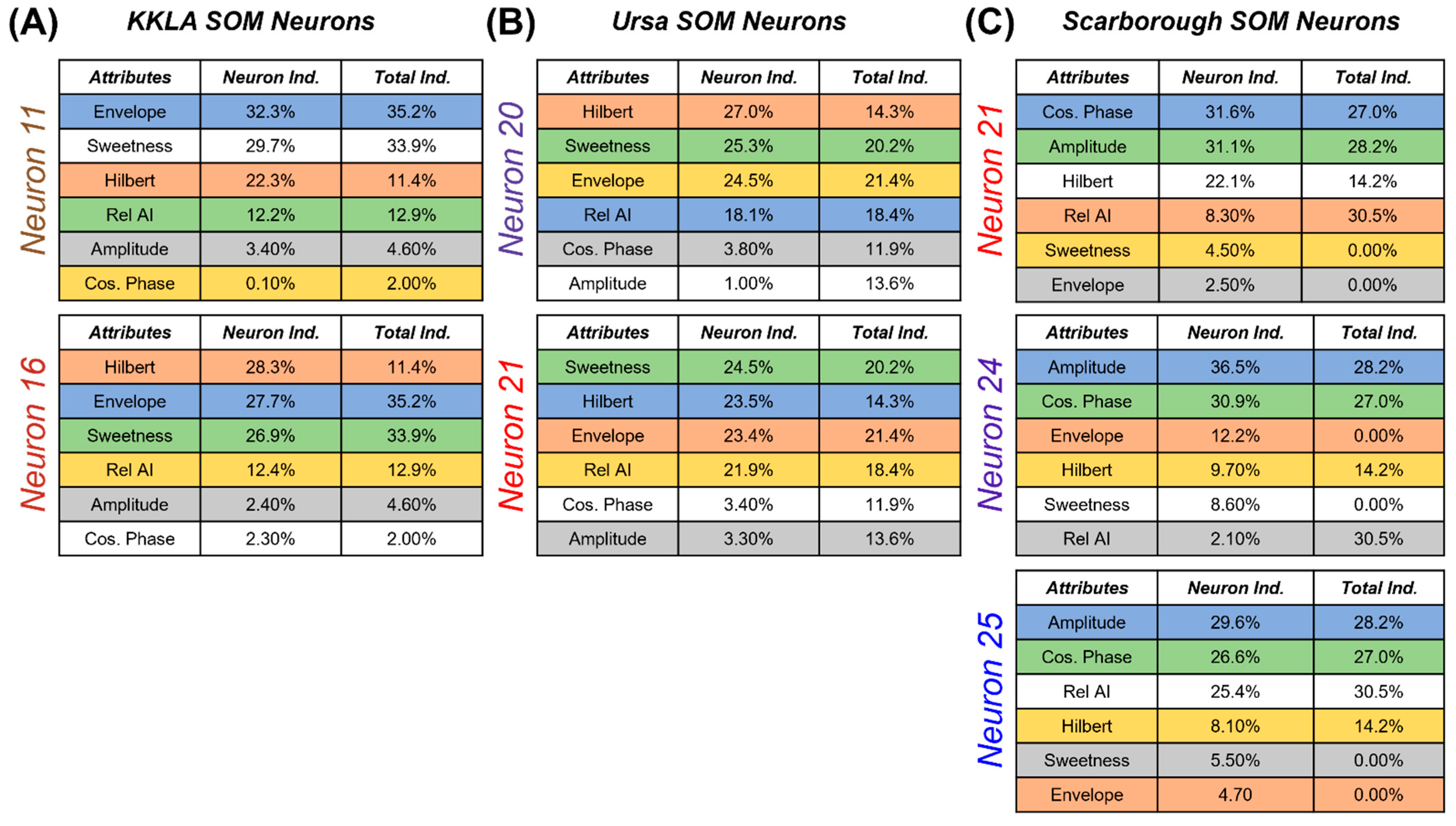
| Instantaneous Attribute Name | Definition | Vertical Slice Example | Uses | Sources |
|---|---|---|---|---|
| Envelope | Calculated from the complex trace to highlight the signal’s instantaneous energy. |  | Instantaneous envelope is useful for highlighting lithology, porosity, and hydrocarbons, since the attribute is sensitive to subtle changes in acoustic impedance. | [31,32] |
| Hilbert | 90-degree transform/rotation of the seismic trace complex trace. |  | Useful for highlighting discontinuities, such as faults or lithology changes, and for analyzing AVO anomalies as the attribute is proportional to reflectivity. | |
| Cosine of Instantaneous Phase | Obtained from taking the cosine of arctangent of the complex trace value divided by the real trace value. |  | The advantage of using cosine of instantaneous phase as opposed to instantaneous phase is that it is a continuous parameter and does not have a discontinuity at ±180°. This attribute is helpful for detecting unconformities, faults, and lateral stratigraphic changes since the attribute tracks reflector continuity. It is also important to note that instantaneous phase is devoid of any amplitude information; therefore, all the events are represented. | [31,32,33] |
| Relative Acoustic Impedance | Calculated using a running summation on the real trace and applying a high-pass Butterworth filter. | 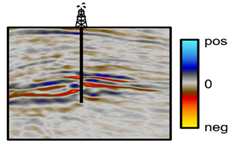 | Since the attribute is showing a relative impedance contrast, it can be useful for identifying sequence boundaries, discontinues, and can potentially indicate porosity or fluid content. | [32,34] |
| Sweetness | Computed by dividing the envelope by the square root of instantaneous frequency. | 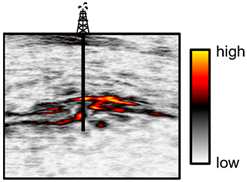 | First discovered by Radovich and Oliveros [35], sweetness is a relative value helpful for determining relative net-to-gross ratios and to identify “sweet spots” in hydrocarbon exploration. | [35,36,37] |
Publisher’s Note: MDPI stays neutral with regard to jurisdictional claims in published maps and institutional affiliations. |
© 2022 by the authors. Licensee MDPI, Basel, Switzerland. This article is an open access article distributed under the terms and conditions of the Creative Commons Attribution (CC BY) license (https://creativecommons.org/licenses/by/4.0/).
Share and Cite
Chenin, J.; Bedle, H. Unsupervised Machine Learning, Multi-Attribute Analysis for Identifying Low Saturation Gas Reservoirs within the Deepwater Gulf of Mexico, and Offshore Australia. Geosciences 2022, 12, 132. https://doi.org/10.3390/geosciences12030132
Chenin J, Bedle H. Unsupervised Machine Learning, Multi-Attribute Analysis for Identifying Low Saturation Gas Reservoirs within the Deepwater Gulf of Mexico, and Offshore Australia. Geosciences. 2022; 12(3):132. https://doi.org/10.3390/geosciences12030132
Chicago/Turabian StyleChenin, Julian, and Heather Bedle. 2022. "Unsupervised Machine Learning, Multi-Attribute Analysis for Identifying Low Saturation Gas Reservoirs within the Deepwater Gulf of Mexico, and Offshore Australia" Geosciences 12, no. 3: 132. https://doi.org/10.3390/geosciences12030132
APA StyleChenin, J., & Bedle, H. (2022). Unsupervised Machine Learning, Multi-Attribute Analysis for Identifying Low Saturation Gas Reservoirs within the Deepwater Gulf of Mexico, and Offshore Australia. Geosciences, 12(3), 132. https://doi.org/10.3390/geosciences12030132






